文章
Dummer. ゛☀
2017年10月01日

Scientific Name
Crassula arborescens (Mill.) Willd.
Common Names
Silver Dollar, Silver Dollar Plant, Silver Dollar Jade, Silver Jade Plant, Chinese Jade, Tree Crassula, Beestebul, Money Plant, Round-Leaved Crassula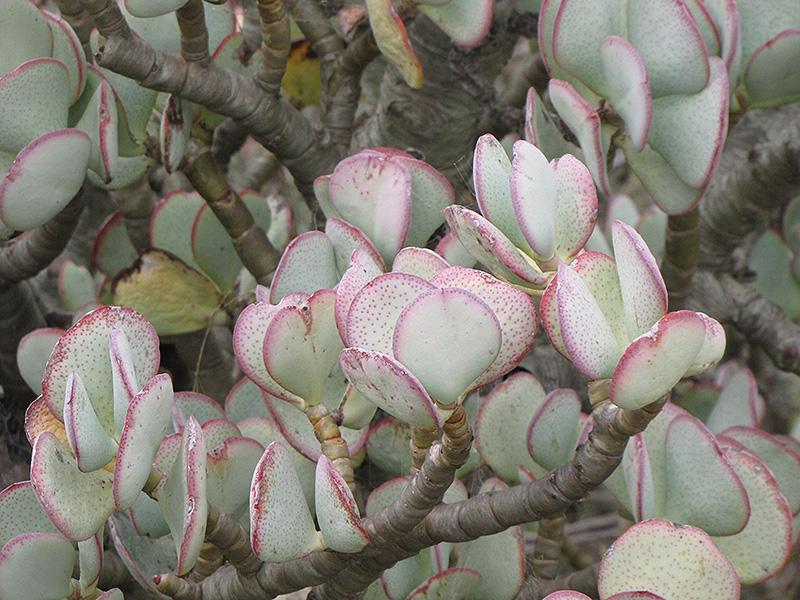
Synonyms
Cotyledon arborescens (basionym), Crassula arborescens subsp. arborescens, Cotyledon punctata, Crassula arborea, Crassula cotyledon, Crassula cotyledonifolia
Scientific Classification
Family: Crassulaceae
Subfamily: Crassuloideae
Genus: Crassula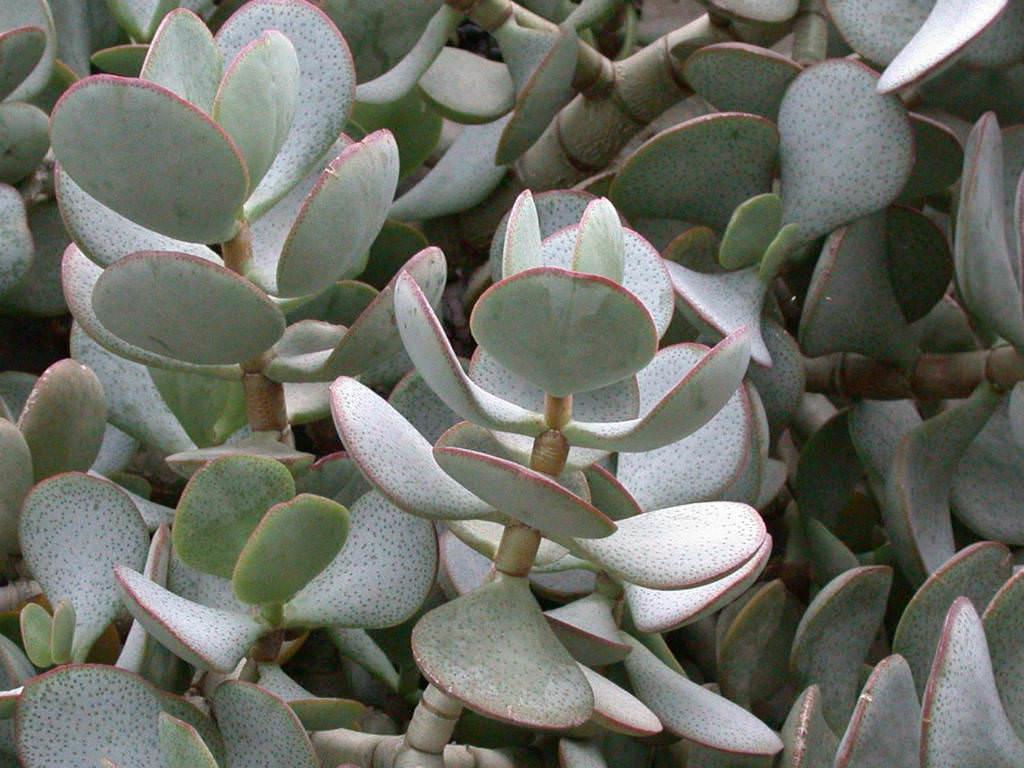
Description
Crassula arborescens is a many branched succulent shrub or small tree, up to 4 feet (1.2 m) tall. It has rounded, fat, silver-gray, up to 3 inches (7.6 cm) long leaves that are often edged maroon and have reddish spots on the upper surface. The star-like flowers are pinkish white in color.
How to Grow and Care
Crassula are easy to grow, but they are susceptible to mealy bugs and fungal diseases. As with all succulents, overwatering is sure to be fatal, so err on the side of too dry rather than too wet. Never let your Crassula sit in water. If you water from beneath by letting the plant sit in a saucer of water, make sure to pour off any excess water after a few minutes.
Repot as needed, preferably during the warm season. To repot a succulent, make sure the soil is dry before repotting, then gently remove the pot.
Crassula are generally started by division, offsets or leaf cuttings. Plants can be easily propagated from a single leaf: sprout leaves by placing them into a succulent or cacti mix, then covering the dish until they sprout.
Crassula arborescens (Mill.) Willd.
Common Names
Silver Dollar, Silver Dollar Plant, Silver Dollar Jade, Silver Jade Plant, Chinese Jade, Tree Crassula, Beestebul, Money Plant, Round-Leaved Crassula

Synonyms
Cotyledon arborescens (basionym), Crassula arborescens subsp. arborescens, Cotyledon punctata, Crassula arborea, Crassula cotyledon, Crassula cotyledonifolia
Scientific Classification
Family: Crassulaceae
Subfamily: Crassuloideae
Genus: Crassula

Description
Crassula arborescens is a many branched succulent shrub or small tree, up to 4 feet (1.2 m) tall. It has rounded, fat, silver-gray, up to 3 inches (7.6 cm) long leaves that are often edged maroon and have reddish spots on the upper surface. The star-like flowers are pinkish white in color.
How to Grow and Care
Crassula are easy to grow, but they are susceptible to mealy bugs and fungal diseases. As with all succulents, overwatering is sure to be fatal, so err on the side of too dry rather than too wet. Never let your Crassula sit in water. If you water from beneath by letting the plant sit in a saucer of water, make sure to pour off any excess water after a few minutes.

Repot as needed, preferably during the warm season. To repot a succulent, make sure the soil is dry before repotting, then gently remove the pot.
Crassula are generally started by division, offsets or leaf cuttings. Plants can be easily propagated from a single leaf: sprout leaves by placing them into a succulent or cacti mix, then covering the dish until they sprout.
2
3
文章
Dummer. ゛☀
2017年10月01日

Scientific Name
Kalanchoe manginii Raym.-Hamet & H. Perrier
Common Names
Chandelier Plant, Beach Bells
Synonyms
Bryophyllum manginii
Scientific Classification
Family: Crassulaceae
Subfamily: Sedoideae
Tribe: Kalanchoeae
Genus: Kalanchoe
Description
Kalanchoe manginii is an evergreen succulent perennial growing up to 12 inches (30 cm) tall and wide, with arching branches of rounded, glossy leaves. It bears few flowered, cyme like panicles of tubular, urn-shaped, red flowers, up to 1.2 inches (3 cm) or more long.
How to Grow and Care
Kalanchoes are not particularly hard to grow, and the flowering varieties are highly rewarding for their colorful and long-lasting flowers. They prefer bright, sunny locations, especially in the summer growing season. During the winter, consider a south-facing window. Water moderately throughout the summer and reduce watering in the winter. Let the soil surface dry out between waterings, and in the winter, the plant can almost dry out. Watch the fleshy leaves for signs of water distress. They prefer warmth. Do not let fall below 55ºF (12.7ºC). An ordinary potting soil mix is fine. Feed bi-weekly in the summer with a liquid fertilizer, or use slow-release pellets.
Kalanchoe manginii Raym.-Hamet & H. Perrier
Common Names
Chandelier Plant, Beach Bells
Synonyms
Bryophyllum manginii
Scientific Classification
Family: Crassulaceae
Subfamily: Sedoideae
Tribe: Kalanchoeae
Genus: Kalanchoe

Description
Kalanchoe manginii is an evergreen succulent perennial growing up to 12 inches (30 cm) tall and wide, with arching branches of rounded, glossy leaves. It bears few flowered, cyme like panicles of tubular, urn-shaped, red flowers, up to 1.2 inches (3 cm) or more long.

How to Grow and Care
Kalanchoes are not particularly hard to grow, and the flowering varieties are highly rewarding for their colorful and long-lasting flowers. They prefer bright, sunny locations, especially in the summer growing season. During the winter, consider a south-facing window. Water moderately throughout the summer and reduce watering in the winter. Let the soil surface dry out between waterings, and in the winter, the plant can almost dry out. Watch the fleshy leaves for signs of water distress. They prefer warmth. Do not let fall below 55ºF (12.7ºC). An ordinary potting soil mix is fine. Feed bi-weekly in the summer with a liquid fertilizer, or use slow-release pellets.
0
0
文章
Dummer. ゛☀
2017年10月01日

Scientific Name
Euphorbia obesa Hook.
Common Names
Basketball, Sea Urchin, Baseball, Living Baseball, Baseball Plant, Gingham, Golf Ball, Vetmensie, Klipnoors
Scientific Classification
Family: Euphorbiaceae
Subfamily: Euphorbioideae
Tribe: Euphorbieae
Subtribe: Euphorbiinae
Genus: Euphorbia
Description
Euphorbia obesa is a spineless, grey-green, dwarf, spherical succulent plant with transverse red-brown or purplish bands. It can grow up to 8 inches (20 cm) tall and up to 3.5 inches (9 cm) in diameter. Rudimentary, caducous leaves. Usually 8, vertical, broad, slightly raised ribs with shallow furrows in between. Small inflorescence borne on short peduncle from stem apices. Female and male flower are born on different plants. The fruit is a slightly three angled capsule, up to 0.3 inch (7 mm) in diameter.
Hardiness
USDA hardiness zone 10a to 11b: from 30 °F (−1.1 °C) to 50 °F (+10 °C).
How to Grow and Care
Euphorbias are very easy to care for. They require a little pampering to become established, but once they are, they are self-sufficient. In fact, more die from too much care and watering than from neglect. Euphorbias need well-draining soil and lots of sunlight. They are not particular about soil pH, but they cannot tolerant wet soil. Unlike most succulents, Euphorbia does not handle long periods of drought well. It may need weekly watering during the summer. Water whenever the soil is dry several inches below the surface. Water deeply, but don’t let them sit in wet soil, which can cause root rot. Add some organic matter or fertilizer to the planting hole. If you are growing them in containers or your soil is poor, feed with a half-strength fertilizer monthly.
Euphorbia can be grown from seed, but they can be difficult to germinate (or even find). It is usually propagated by cuttings. This can be tricky, because of the exuding sap.
Euphorbia obesa Hook.
Common Names
Basketball, Sea Urchin, Baseball, Living Baseball, Baseball Plant, Gingham, Golf Ball, Vetmensie, Klipnoors

Scientific Classification
Family: Euphorbiaceae
Subfamily: Euphorbioideae
Tribe: Euphorbieae
Subtribe: Euphorbiinae
Genus: Euphorbia

Description
Euphorbia obesa is a spineless, grey-green, dwarf, spherical succulent plant with transverse red-brown or purplish bands. It can grow up to 8 inches (20 cm) tall and up to 3.5 inches (9 cm) in diameter. Rudimentary, caducous leaves. Usually 8, vertical, broad, slightly raised ribs with shallow furrows in between. Small inflorescence borne on short peduncle from stem apices. Female and male flower are born on different plants. The fruit is a slightly three angled capsule, up to 0.3 inch (7 mm) in diameter.

Hardiness
USDA hardiness zone 10a to 11b: from 30 °F (−1.1 °C) to 50 °F (+10 °C).
How to Grow and Care
Euphorbias are very easy to care for. They require a little pampering to become established, but once they are, they are self-sufficient. In fact, more die from too much care and watering than from neglect. Euphorbias need well-draining soil and lots of sunlight. They are not particular about soil pH, but they cannot tolerant wet soil. Unlike most succulents, Euphorbia does not handle long periods of drought well. It may need weekly watering during the summer. Water whenever the soil is dry several inches below the surface. Water deeply, but don’t let them sit in wet soil, which can cause root rot. Add some organic matter or fertilizer to the planting hole. If you are growing them in containers or your soil is poor, feed with a half-strength fertilizer monthly.

Euphorbia can be grown from seed, but they can be difficult to germinate (or even find). It is usually propagated by cuttings. This can be tricky, because of the exuding sap.
0
0
文章
Dummer. ゛☀
2017年10月01日

Scientific Name
Curio rowleyanus (H. Jacobsen) P.V. Heath
Common Names
String of Bananas, String of Pearls, Banana Vine, Necklace Plant, String of Fishhooks, Fishhook Senecio, Creeping-Berry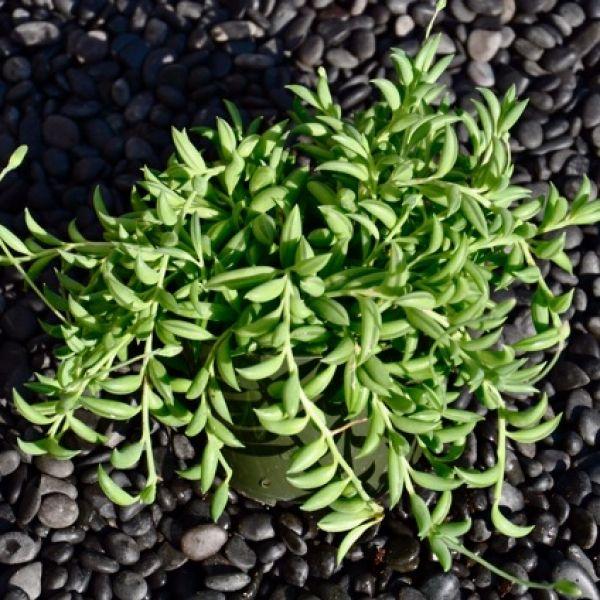
Synonyms
Senecio radicans, Cacalia radicans (basionym), Kleinia radicans
Scientific Classification
Family: Asteraceae
Subfamily: Asteroideae
Tribe: Senecioneae
Subtribe: Senecioninae
Genus: Curio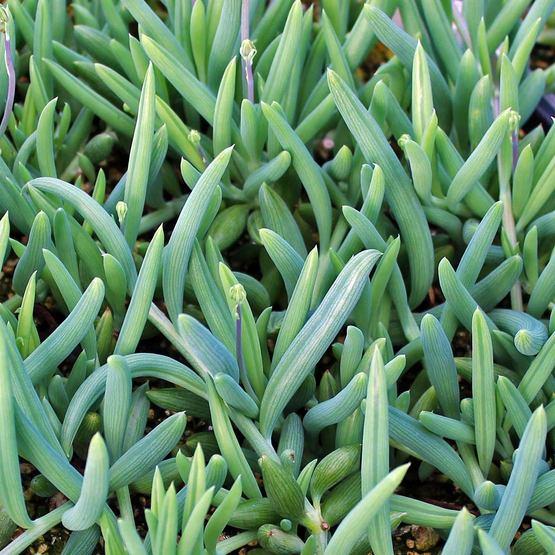
Description
Curio radicans is a fast-growing succulent with vines that can reach at least 3 feet (90 cm) long. The small, up to 1.2 inches (3 cm) long, green, pointed leaves grow single-file along the cascading stems, with the sides of the leaves partly translucent, allowing sunlight to shine through. The flowers are small, cinnamon-scented and white in color.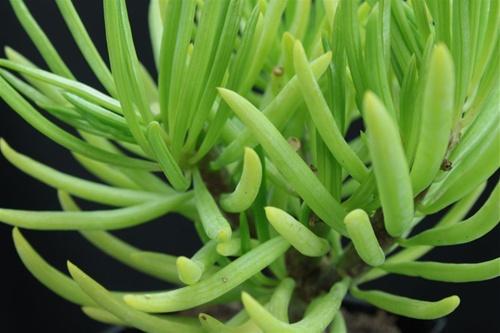
How to Grow and Care
Established plants are extremely drought tolerant. They do need some water, during the summer, but do not leave the soil wet for prolonged periods. Allow the soil to dry out between waterings in the winter, when they are somewhat dormant. Since they are growing in sandy soil, nutrients will need to be replenished. Fertilize annually, but lightly. Too much fertilizer will cause a lot of leggy growth.
Taller varieties can get floppy. You can prune them back to where the stem is firm, in very early spring. You can even root the cuttings.
Plants can be divided or repotted in early spring. If you are growing them in containers, they enjoy spending the summer outdoors. Wait until there is no danger of frost and move them back indoors in the fall.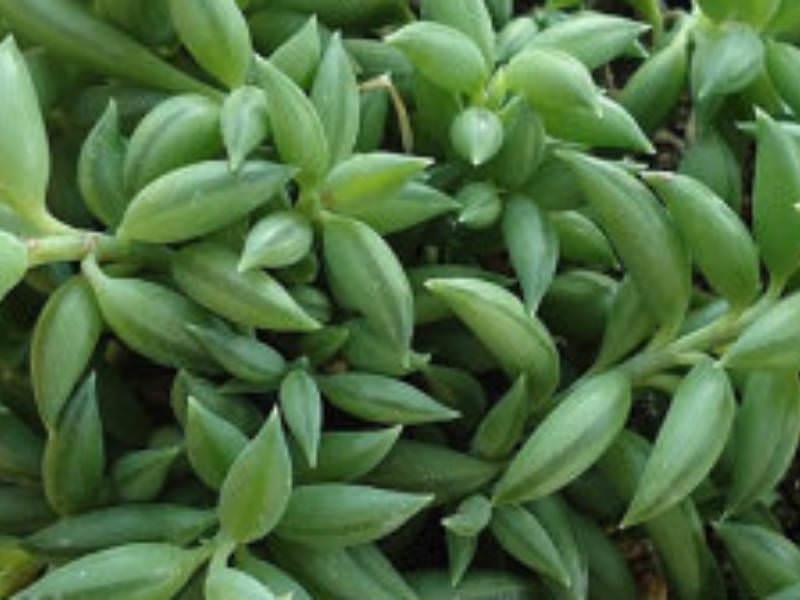
Senecio can be grown from either seed or cuttings. Seeds prefer warm temperatures (55˚F / 13˚C). And constant moisture to germinate.
Curio rowleyanus (H. Jacobsen) P.V. Heath
Common Names
String of Bananas, String of Pearls, Banana Vine, Necklace Plant, String of Fishhooks, Fishhook Senecio, Creeping-Berry

Synonyms
Senecio radicans, Cacalia radicans (basionym), Kleinia radicans
Scientific Classification
Family: Asteraceae
Subfamily: Asteroideae
Tribe: Senecioneae
Subtribe: Senecioninae
Genus: Curio

Description
Curio radicans is a fast-growing succulent with vines that can reach at least 3 feet (90 cm) long. The small, up to 1.2 inches (3 cm) long, green, pointed leaves grow single-file along the cascading stems, with the sides of the leaves partly translucent, allowing sunlight to shine through. The flowers are small, cinnamon-scented and white in color.

How to Grow and Care
Established plants are extremely drought tolerant. They do need some water, during the summer, but do not leave the soil wet for prolonged periods. Allow the soil to dry out between waterings in the winter, when they are somewhat dormant. Since they are growing in sandy soil, nutrients will need to be replenished. Fertilize annually, but lightly. Too much fertilizer will cause a lot of leggy growth.
Taller varieties can get floppy. You can prune them back to where the stem is firm, in very early spring. You can even root the cuttings.
Plants can be divided or repotted in early spring. If you are growing them in containers, they enjoy spending the summer outdoors. Wait until there is no danger of frost and move them back indoors in the fall.

Senecio can be grown from either seed or cuttings. Seeds prefer warm temperatures (55˚F / 13˚C). And constant moisture to germinate.
1
1
文章
Dummer. ゛☀
2017年10月01日

Scientific Name
Sedum rubrotinctum R.T.Clausen
It has also been classified as a hybrid plant of Sedum pachyphyllum and Sedum stahlii, named Sedum × rubrotinctum.
Common Names
Jelly Bean Plant, Jelly Bean, Pork and Beans, Brown Beans, Christmas Cheer, Banana Cactus
Scientific Classification
Family: Crassulaceae
Subfamily: Sedoideae
Tribe: Sedeae
Subtribe: Sedinae
Genus: Sedum
Description
Sedum rubrotinctum is an evergreen, succulent perennial with sprawling, leaning stems, up to 8 inches (20 cm) tall. The leaves are jelly bean shaped, 0.75 inch (1.9 cm) long, green with red-brown tips which turn to bronze in the summer months. The flowers are small, star-shaped and yellow in color.
How to Grow and Care
When growing Sedum, keep in mind that Sedum plants need very little attention or care. They will thrive in conditions that many other plants thrive in, but will do just as well in less hospitable areas. They are ideal for that part of your yard that gets too much sun or too little water to grow anything else. A common name for Sedum is Stonecrop, due to the fact that many gardeners joke that only stones need less care and live longer.
Sedum is easily planted. For shorter varieties, simply laying the Sedum on the ground where you want it to grow is normally enough to get the Sedum plant started there. They will send out roots from wherever the stem is touching the ground and root itself. If you would like to further ensure that the plant will start there, you can add a very thin covering of soil over the plant.
For taller Sedum varieties, you can break off one of the stems and push it into the ground where you would like to grow it.
Sedum rubrotinctum R.T.Clausen
It has also been classified as a hybrid plant of Sedum pachyphyllum and Sedum stahlii, named Sedum × rubrotinctum.

Common Names
Jelly Bean Plant, Jelly Bean, Pork and Beans, Brown Beans, Christmas Cheer, Banana Cactus
Scientific Classification
Family: Crassulaceae
Subfamily: Sedoideae
Tribe: Sedeae
Subtribe: Sedinae
Genus: Sedum

Description
Sedum rubrotinctum is an evergreen, succulent perennial with sprawling, leaning stems, up to 8 inches (20 cm) tall. The leaves are jelly bean shaped, 0.75 inch (1.9 cm) long, green with red-brown tips which turn to bronze in the summer months. The flowers are small, star-shaped and yellow in color.

How to Grow and Care
When growing Sedum, keep in mind that Sedum plants need very little attention or care. They will thrive in conditions that many other plants thrive in, but will do just as well in less hospitable areas. They are ideal for that part of your yard that gets too much sun or too little water to grow anything else. A common name for Sedum is Stonecrop, due to the fact that many gardeners joke that only stones need less care and live longer.

Sedum is easily planted. For shorter varieties, simply laying the Sedum on the ground where you want it to grow is normally enough to get the Sedum plant started there. They will send out roots from wherever the stem is touching the ground and root itself. If you would like to further ensure that the plant will start there, you can add a very thin covering of soil over the plant.
For taller Sedum varieties, you can break off one of the stems and push it into the ground where you would like to grow it.
0
2
文章
Dummer. ゛☀
2017年10月01日

Scientific Name
Fenestraria rhopalophylla (Schltr. & Diels) N. E. Br.
Common Names
Baby Toes, Baby’s Toes, Window Plant
Scientific Classification
Family: Aizoaceae
Subfamily: Ruschioideae
Tribe: Ruschieae
Genus: Fenestraria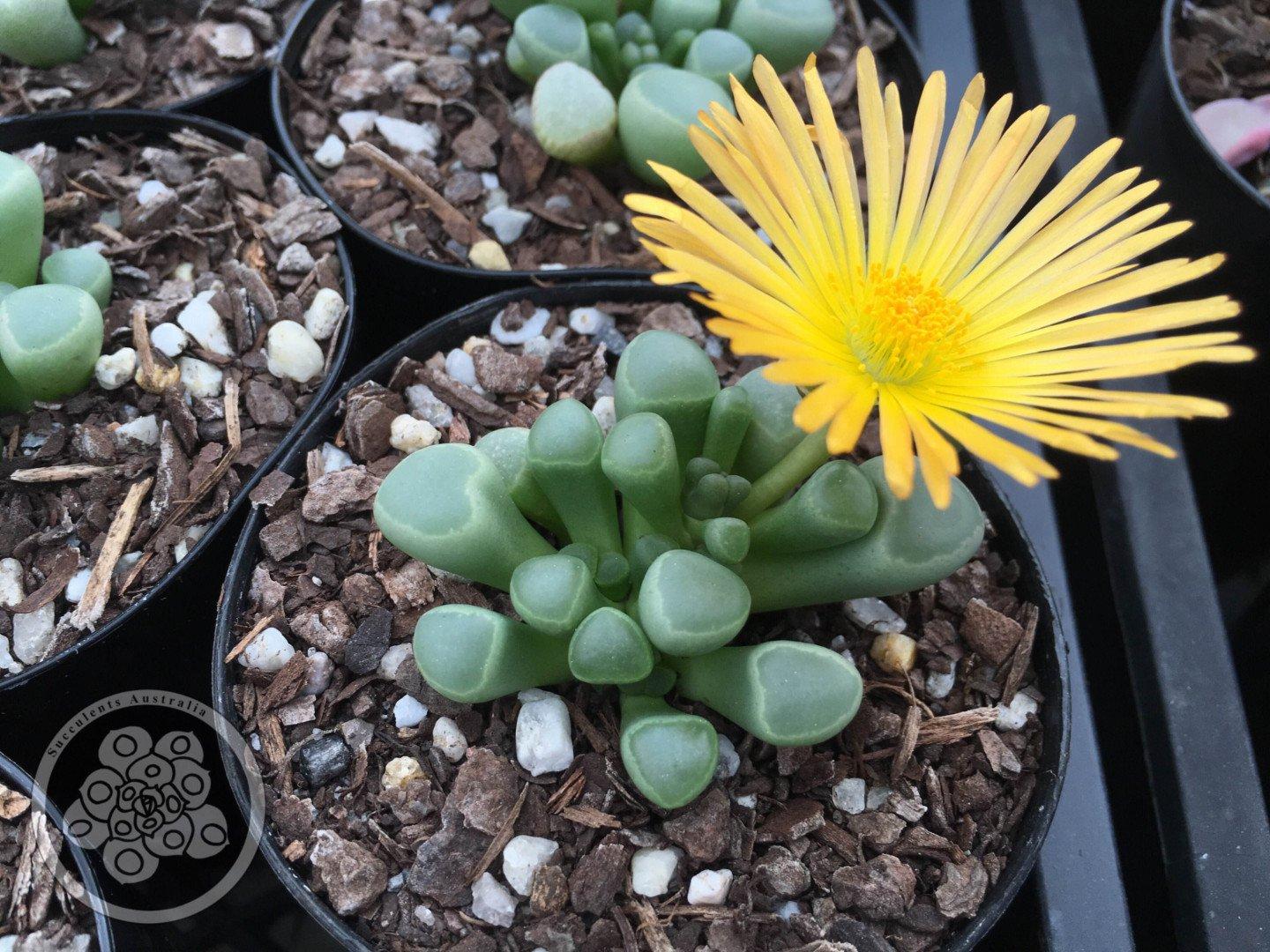
Description
Fenestraria rhopalophylla is an evergreen, perennial succulent, up to 6 inches (15 cm) tall. Not present or very reduced stem. The tip of each leaf is transparent, and diffuse the light to the rest of the leaf. The roots are thick, shallow, and spreading. The leaves are glaucous green, smooth, up to 1.5 inches (4 cm) long and with a convex apex. Medium-large up to 1.2 inch (3 cm) in diametar, pure white, solitary or in groups of up to three flowers borne on long pedicels.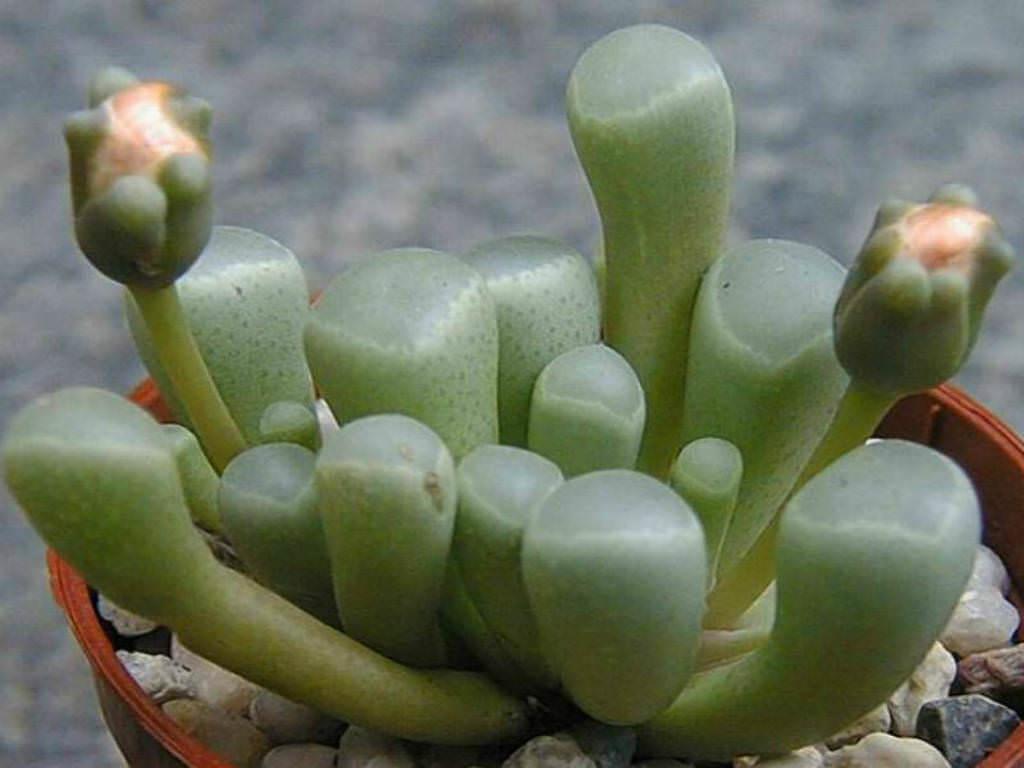
Hardiness
USDA hardiness zone 10a to 11b: from 30 °F (−1.1 °C) to 50 °F (+10 °C).
How to Grow and Care
Fenestraria prefer sandy soil and should be watered sparingly at all times to avoid root rot and split leaves. They need to be kept somewhat dry in the summer. Mix equals parts potting soil with pumice or perlite. Outdoors, grow in full to part sun; indoors, provide bright indirect light. Water thoroughly when soil is dry to the touch. Fenestrarias are somewhat frost tolerant, but protection is advisable to prevent scarring.
They are usually propagated by seed but sometimes by cuttings. Like many succulents, Fenestrarias produces offsets as the clusters of leaves mature and spread. These are easy to divide from the main clump and will readily produce another plant.
Fenestraria rhopalophylla (Schltr. & Diels) N. E. Br.
Common Names
Baby Toes, Baby’s Toes, Window Plant
Scientific Classification
Family: Aizoaceae
Subfamily: Ruschioideae
Tribe: Ruschieae
Genus: Fenestraria

Description
Fenestraria rhopalophylla is an evergreen, perennial succulent, up to 6 inches (15 cm) tall. Not present or very reduced stem. The tip of each leaf is transparent, and diffuse the light to the rest of the leaf. The roots are thick, shallow, and spreading. The leaves are glaucous green, smooth, up to 1.5 inches (4 cm) long and with a convex apex. Medium-large up to 1.2 inch (3 cm) in diametar, pure white, solitary or in groups of up to three flowers borne on long pedicels.

Hardiness
USDA hardiness zone 10a to 11b: from 30 °F (−1.1 °C) to 50 °F (+10 °C).
How to Grow and Care
Fenestraria prefer sandy soil and should be watered sparingly at all times to avoid root rot and split leaves. They need to be kept somewhat dry in the summer. Mix equals parts potting soil with pumice or perlite. Outdoors, grow in full to part sun; indoors, provide bright indirect light. Water thoroughly when soil is dry to the touch. Fenestrarias are somewhat frost tolerant, but protection is advisable to prevent scarring.

They are usually propagated by seed but sometimes by cuttings. Like many succulents, Fenestrarias produces offsets as the clusters of leaves mature and spread. These are easy to divide from the main clump and will readily produce another plant.
1
0
文章
Dummer. ゛☀
2017年10月01日

Scientific Name
Fenestraria rhopalophylla subsp. aurantiaca (N.E.Br.) H.E.K.Hartmann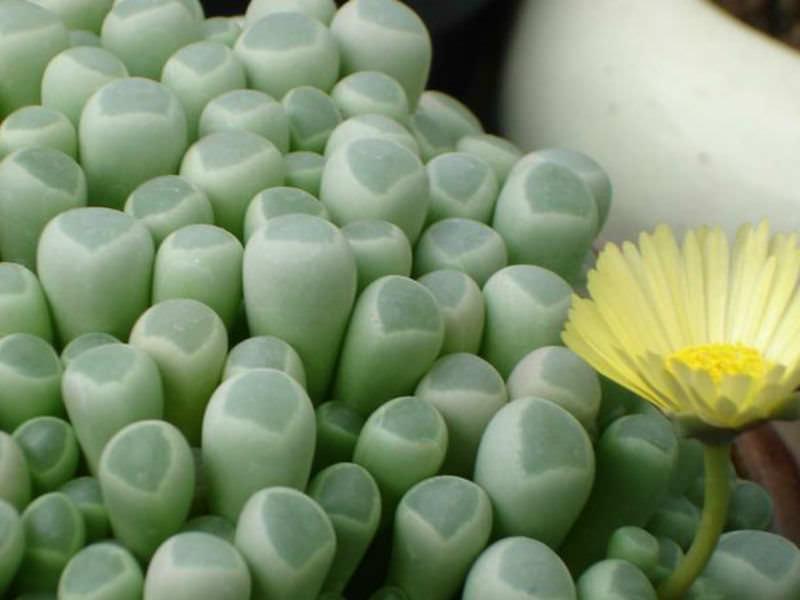
Common Names
Baby Toes, Baby’s Toes, Window Plant
Synonyms
Fenestraria aurantiaca
The status of Fenestraria aurantiaca is under review to determine whether its proper status is that of a full species or a subspecies of Fenestraria rhopalophylla.
Scientific Classification
Family: Aizoaceae
Subfamily: Ruschioideae
Tribe: Ruschieae
Genus: Fenestraria
Description
Fenestraria rhopalophylla is an evergreen, perennial succulent, up to 6 inches (15 cm) tall. Not present or very reduced stem. The tip of each leaf is transparent, and diffuse the light to the rest of the leaf. The roots are thick, shallow, and spreading. The leaves are glaucous green, smooth, up to 1.5 inches (4 cm) long and with a convex apex. Medium-large up to 1.2 inch (3 cm) in diametar, rich golden yellow, solitary or in groups of up to three flowers borne on long pedicels.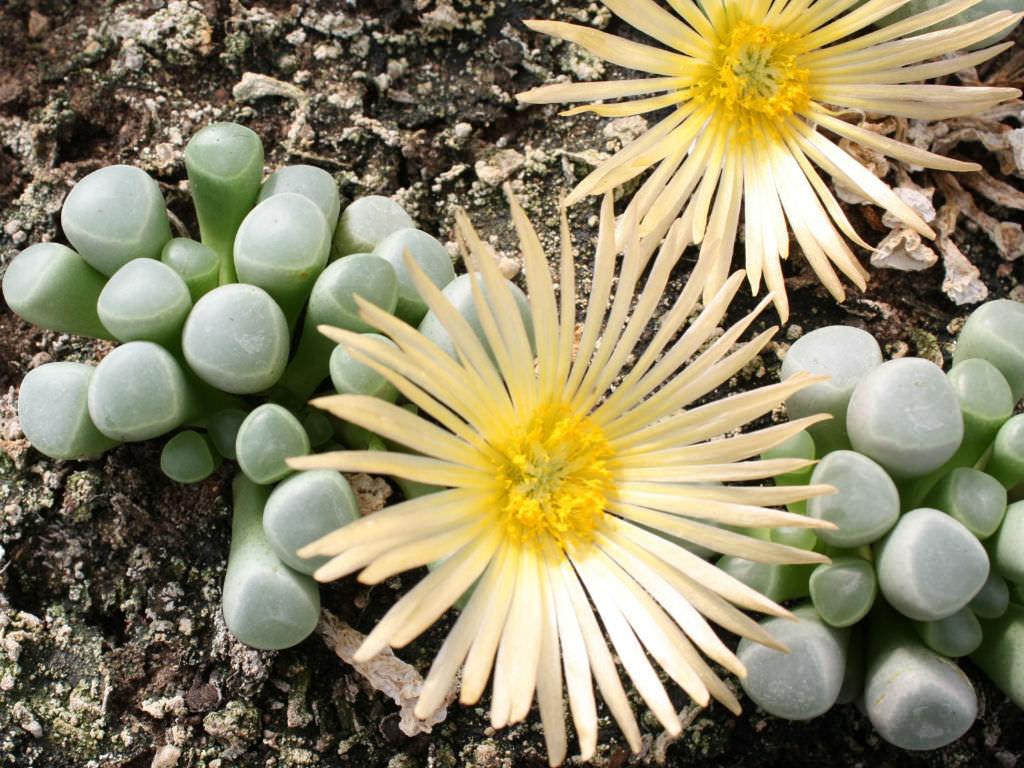
How to Grow and Care
Fenestraria prefer sandy soil and should be watered sparingly at all times to avoid root rot and split leaves. They need to be kept somewhat dry in the summer. Mix equals parts potting soil with pumice or perlite. Outdoors, grow in full to part sun; indoors, provide bright indirect light. Water thoroughly when soil is dry to the touch. Fenestrarias are somewhat frost tolerant, but protection is advisable to prevent scarring. They are usually propagated by seed but sometimes by cuttings. Like many succulents, Fenestrarias produces offsets as the clusters of leaves mature and spread. These are easy to divide from the main clump and will readily produce another plant.
Fenestraria rhopalophylla subsp. aurantiaca (N.E.Br.) H.E.K.Hartmann

Common Names
Baby Toes, Baby’s Toes, Window Plant
Synonyms
Fenestraria aurantiaca
The status of Fenestraria aurantiaca is under review to determine whether its proper status is that of a full species or a subspecies of Fenestraria rhopalophylla.
Scientific Classification
Family: Aizoaceae
Subfamily: Ruschioideae
Tribe: Ruschieae
Genus: Fenestraria

Description
Fenestraria rhopalophylla is an evergreen, perennial succulent, up to 6 inches (15 cm) tall. Not present or very reduced stem. The tip of each leaf is transparent, and diffuse the light to the rest of the leaf. The roots are thick, shallow, and spreading. The leaves are glaucous green, smooth, up to 1.5 inches (4 cm) long and with a convex apex. Medium-large up to 1.2 inch (3 cm) in diametar, rich golden yellow, solitary or in groups of up to three flowers borne on long pedicels.

How to Grow and Care
Fenestraria prefer sandy soil and should be watered sparingly at all times to avoid root rot and split leaves. They need to be kept somewhat dry in the summer. Mix equals parts potting soil with pumice or perlite. Outdoors, grow in full to part sun; indoors, provide bright indirect light. Water thoroughly when soil is dry to the touch. Fenestrarias are somewhat frost tolerant, but protection is advisable to prevent scarring. They are usually propagated by seed but sometimes by cuttings. Like many succulents, Fenestrarias produces offsets as the clusters of leaves mature and spread. These are easy to divide from the main clump and will readily produce another plant.
0
0
文章
Dummer. ゛☀
2017年10月01日

Scientific Name
Zamioculcas zamiifolia (Lodd.) Engl.
Common Names
ZZ Plant, Zanzibar Gem, Aroid Palm, Eternity Plant, Succulent Philodendron, Money Tree, Golden Tree, Zu Zu Plant, Fat Boy
Synonyms
Caladium zamiifolium, Zamioculcas lanceolata, Zamioculcas loddigesii
Scientific Classification
Family: Araceae
Subfamily: Asclepiadoideae
Tribe: Marsdenieae
Genus: Zamioculcas
Description
Zamioculcas zamiifolia is a herbaceous plant growing up to 2 feet (60 cm) tall, from a stout underground, succulent rhizome. It is normally evergreen, but becomes deciduous during drought, surviving drought due to the large potato-like rhizome that stores water until rainfall resumes. The leaves are pinnate, smooth, shiny, and dark green, up to 2 feet (60 cm) long, with 6-8 pairs of leaflets up to 6 inches (15 cm) long. The flowers are produced in a small bright yellow to brown or bronze spadix up to 3 inches (7.5 cm) long, partly hidden among the leaf bases. Flowering is from mid summer to early autumn.
How to Grow and Care
ZZ Plant care starts with a lack of care. In fact, ZZ Plants will do better if you leave them alone. Much like cacti, they need less rather than more water. Water the plant only when the soil has dried out. The rare way you can kill this plant is to over water it. A ZZ Plant turning yellow means that it is getting too much water and its underground rhizomes may be rotting. So if you remember nothing else about caring for a ZZ Plant, just remember to forget to water it. It can survive months without water, but will grow faster if watered somewhat regularly. ZZ Plants are happy without fertilizer, but if you would like, you can give the plants half strength fertilizer one to two times a year and only in the summer months.
Zamioculcas zamiifolia (Lodd.) Engl.

Common Names
ZZ Plant, Zanzibar Gem, Aroid Palm, Eternity Plant, Succulent Philodendron, Money Tree, Golden Tree, Zu Zu Plant, Fat Boy
Synonyms
Caladium zamiifolium, Zamioculcas lanceolata, Zamioculcas loddigesii
Scientific Classification
Family: Araceae
Subfamily: Asclepiadoideae
Tribe: Marsdenieae
Genus: Zamioculcas

Description
Zamioculcas zamiifolia is a herbaceous plant growing up to 2 feet (60 cm) tall, from a stout underground, succulent rhizome. It is normally evergreen, but becomes deciduous during drought, surviving drought due to the large potato-like rhizome that stores water until rainfall resumes. The leaves are pinnate, smooth, shiny, and dark green, up to 2 feet (60 cm) long, with 6-8 pairs of leaflets up to 6 inches (15 cm) long. The flowers are produced in a small bright yellow to brown or bronze spadix up to 3 inches (7.5 cm) long, partly hidden among the leaf bases. Flowering is from mid summer to early autumn.

How to Grow and Care
ZZ Plant care starts with a lack of care. In fact, ZZ Plants will do better if you leave them alone. Much like cacti, they need less rather than more water. Water the plant only when the soil has dried out. The rare way you can kill this plant is to over water it. A ZZ Plant turning yellow means that it is getting too much water and its underground rhizomes may be rotting. So if you remember nothing else about caring for a ZZ Plant, just remember to forget to water it. It can survive months without water, but will grow faster if watered somewhat regularly. ZZ Plants are happy without fertilizer, but if you would like, you can give the plants half strength fertilizer one to two times a year and only in the summer months.
1
2
文章
Dummer. ゛☀
2017年10月01日

Scientific Name
Hoya compacta C.M. Burton
Common Names
Hindu Rope Plant, Hindu Rope, Hindu Rope Hoya, Indian Rope, Angel Rope, Wax Plant, Porcelain Flower, Krinkle Kurl
Synonyms
Hoya carnosa f. compacta, Hoya carnosa ‘Compacta’, Hoya compacta ‘Krinkle Kurl’
Scientific Classification
Family: Apocynaceae
Subfamily: Asclepiadoideae
Tribe: Marsdenieae
Genus: Hoya
Description
Hoya compacta is draping succulent vine that produce clusters of star-shaped waxy flowers. The curly leaves grow close on the vine making it possible to miss new peduncles and buds until they are quite big. The leaves vary in size and color, but they can be described as curly H. carnosa leaves. The flowers are mostly pale pink and the white corona has a red ring in the middle. The flowers form almost round balls and you can find 30-50 flowers in an umbel. Each flower is up to 0.6 inch (1.5 cm) across. The flowers last about one week.
How to Grow and Care
Hoya plants don’t ask for much, beyond the well-draining soil and the warm humid conditions that many tropical flowers crave. They don’t like wet feet or heavy soil, and as many grow as epiphytes in nature (similar to bromeliads and orchids). Give them at least a half day of sunshine, and bring them indoors when temperatures drop below 50 degrees F (10 degrees C).
When your Hoyas finishes blooming, leave the flower stalk, as it may produce new flowers. Removing the stalk forces the plant to produce a new stalk, which delays blooming and wastes the plant’s energy. They are light feeders, and a monthly drink of compost tea or dilute fish emulsion provides all the nutrition these tropicals need.
Hoya compacta C.M. Burton

Common Names
Hindu Rope Plant, Hindu Rope, Hindu Rope Hoya, Indian Rope, Angel Rope, Wax Plant, Porcelain Flower, Krinkle Kurl
Synonyms
Hoya carnosa f. compacta, Hoya carnosa ‘Compacta’, Hoya compacta ‘Krinkle Kurl’
Scientific Classification
Family: Apocynaceae
Subfamily: Asclepiadoideae
Tribe: Marsdenieae

Genus: Hoya
Description
Hoya compacta is draping succulent vine that produce clusters of star-shaped waxy flowers. The curly leaves grow close on the vine making it possible to miss new peduncles and buds until they are quite big. The leaves vary in size and color, but they can be described as curly H. carnosa leaves. The flowers are mostly pale pink and the white corona has a red ring in the middle. The flowers form almost round balls and you can find 30-50 flowers in an umbel. Each flower is up to 0.6 inch (1.5 cm) across. The flowers last about one week.

How to Grow and Care
Hoya plants don’t ask for much, beyond the well-draining soil and the warm humid conditions that many tropical flowers crave. They don’t like wet feet or heavy soil, and as many grow as epiphytes in nature (similar to bromeliads and orchids). Give them at least a half day of sunshine, and bring them indoors when temperatures drop below 50 degrees F (10 degrees C).

When your Hoyas finishes blooming, leave the flower stalk, as it may produce new flowers. Removing the stalk forces the plant to produce a new stalk, which delays blooming and wastes the plant’s energy. They are light feeders, and a monthly drink of compost tea or dilute fish emulsion provides all the nutrition these tropicals need.
1
0
文章
Dummer. ゛☀
2017年10月01日

Scientific Name
Aloe vera (L.) Burm.f.
Common Names
Aloe Vera, Medicinal Aloe, Barbados Aloe, Chinese Aloe, Indian Aloe, Medicine Plant, True Aloe, Burn Aloe, First Aid Plant, Bitter Aloe, Wand of Heaven, Miracle Plant, Savila
Synonyms
Aloe vulgaris, Aloe indica, Aloe barbadensis var. chinensis, Aloe elongata, Aloe vera var. littoralis, Aloe perfoliata var. vera, Aloe perfoliata var. barbadensis, Aloe flava, Aloe chinensis, Aloe barbadensis, Aloe lanzae
Scientific Classification
Family: Xanthorrhoeaceae
Subfamily: Asphodeloideae
Genus: Aloe
Description
Aloe vera is a stemless or very short-stemmed succulent plant growing up to 40 inches (1 m) tall, spreading by offsets. The leaves are thick and fleshy, green to grey-green, with some varieties showing white flecks on the upper and lower stem surfaces. The margin of the leaf is serrated and has small white teeth. The flowers are produced in summer on a spike up to 35 inches (90 cm) tall, each flower being pendulous, with a yellow tubular corolla up to 1.2 inches (3 cm) long.
Hardiness
USDA hardiness zone 9a to 11b: from 25 °F (−3.9 °C) to 50 °F (+10 °C).
How to Grow and Care
The first step in Aloe Vera care is to realize that this plant is a succulent. Like cacti, succulents do best in dry conditions. When growing Aloe Vera plants, plant them in a cactus potting soil mix or a regular potting soil that has been amended with additional perlite or building sand. Also, make sure that the pot has plenty of drainage holes. It cannot tolerate standing water.
One important thing in the care of Aloe Vera houseplants is that they have proper light. They need bright light, so they do best in south- or west-facing windows. Another important part of how to grow an Aloe Vera is to water the plant properly. The soil should be allowed to go completely dry before being watered.
Uses
Aloe vera has been used for medicinal purposes for centuries. Native to North Africa, Southern Europe, and the Canary Islands, today it is grown in tropical climates worldwide.
Aloe vera (L.) Burm.f.

Common Names
Aloe Vera, Medicinal Aloe, Barbados Aloe, Chinese Aloe, Indian Aloe, Medicine Plant, True Aloe, Burn Aloe, First Aid Plant, Bitter Aloe, Wand of Heaven, Miracle Plant, Savila
Synonyms
Aloe vulgaris, Aloe indica, Aloe barbadensis var. chinensis, Aloe elongata, Aloe vera var. littoralis, Aloe perfoliata var. vera, Aloe perfoliata var. barbadensis, Aloe flava, Aloe chinensis, Aloe barbadensis, Aloe lanzae

Scientific Classification
Family: Xanthorrhoeaceae
Subfamily: Asphodeloideae
Genus: Aloe
Description
Aloe vera is a stemless or very short-stemmed succulent plant growing up to 40 inches (1 m) tall, spreading by offsets. The leaves are thick and fleshy, green to grey-green, with some varieties showing white flecks on the upper and lower stem surfaces. The margin of the leaf is serrated and has small white teeth. The flowers are produced in summer on a spike up to 35 inches (90 cm) tall, each flower being pendulous, with a yellow tubular corolla up to 1.2 inches (3 cm) long.

Hardiness
USDA hardiness zone 9a to 11b: from 25 °F (−3.9 °C) to 50 °F (+10 °C).
How to Grow and Care
The first step in Aloe Vera care is to realize that this plant is a succulent. Like cacti, succulents do best in dry conditions. When growing Aloe Vera plants, plant them in a cactus potting soil mix or a regular potting soil that has been amended with additional perlite or building sand. Also, make sure that the pot has plenty of drainage holes. It cannot tolerate standing water.

One important thing in the care of Aloe Vera houseplants is that they have proper light. They need bright light, so they do best in south- or west-facing windows. Another important part of how to grow an Aloe Vera is to water the plant properly. The soil should be allowed to go completely dry before being watered.

Uses
Aloe vera has been used for medicinal purposes for centuries. Native to North Africa, Southern Europe, and the Canary Islands, today it is grown in tropical climates worldwide.
0
1
文章
Dummer. ゛☀
2017年10月01日

Scientific Name
Kalanchoe daigremontiana Raym.-Hamet & H. Perrier
Common Names
Mother of Thousands, Alligator Plant, Devil’s Backbone, Mexican Hat Plant
Synonyms
Bryophyllum daigremontianum, Kalanchoe daigremontianum
Scientific Classification
Family: Crassulaceae
Subfamily: Sedoideae
Tribe: Kalanchoeae
Genus: Kalanchoe
Description
Kalanchoe daigremontiana is an upright succulent perennial, up to 3 feet (1 m) tall, with opposite, fleshy oblong-lanceolate, grey-green leaves, often spotted with brown-red and with a row of plantlets on each edge. The plantlets form roots while on the plant. The leaves reach up to 8 inches (20 cm) long and up to 1.2 inches (3 cm) wide. The flowers are tubular, greyish pink in color, up to 1 inch (2.5 cm) long.
Hardiness
USDA hardiness zone 9b to 11b: from 25 °F (−3.9 °C) to 50 °F (+10 °C).
How to Grow and Care
Kalanchoes are not particularly hard to grow, and the flowering varieties are highly rewarding for their colorful and long-lasting flowers. They prefer bright, sunny locations, especially in the summer growing season. During the winter, consider a south-facing window. Water moderately throughout the summer and reduce watering in the winter. Let the soil surface dry out between waterings, and in the winter, the plant can almost dry out. Watch the fleshy leaves for signs of water distress. They prefer warmth. Do not let fall below 55ºF (12.7ºC). An ordinary potting soil mix is fine. Feed bi-weekly in the summer with a liquid fertilizer, or use slow-release pellets.
Kalanchoe daigremontiana Raym.-Hamet & H. Perrier

Common Names
Mother of Thousands, Alligator Plant, Devil’s Backbone, Mexican Hat Plant
Synonyms
Bryophyllum daigremontianum, Kalanchoe daigremontianum
Scientific Classification
Family: Crassulaceae
Subfamily: Sedoideae
Tribe: Kalanchoeae
Genus: Kalanchoe

Description
Kalanchoe daigremontiana is an upright succulent perennial, up to 3 feet (1 m) tall, with opposite, fleshy oblong-lanceolate, grey-green leaves, often spotted with brown-red and with a row of plantlets on each edge. The plantlets form roots while on the plant. The leaves reach up to 8 inches (20 cm) long and up to 1.2 inches (3 cm) wide. The flowers are tubular, greyish pink in color, up to 1 inch (2.5 cm) long.

Hardiness
USDA hardiness zone 9b to 11b: from 25 °F (−3.9 °C) to 50 °F (+10 °C).
How to Grow and Care
Kalanchoes are not particularly hard to grow, and the flowering varieties are highly rewarding for their colorful and long-lasting flowers. They prefer bright, sunny locations, especially in the summer growing season. During the winter, consider a south-facing window. Water moderately throughout the summer and reduce watering in the winter. Let the soil surface dry out between waterings, and in the winter, the plant can almost dry out. Watch the fleshy leaves for signs of water distress. They prefer warmth. Do not let fall below 55ºF (12.7ºC). An ordinary potting soil mix is fine. Feed bi-weekly in the summer with a liquid fertilizer, or use slow-release pellets.
2
1
文章
Dummer. ゛☀
2017年10月01日

Scientific Name
Kalanchoe pinnata (Lam.) Pers.
Common Names
Air Plant, Cathedral Bells, Life Plant, Miracle Leaf, Goethe Plant, Curtain Plant, Floppers, Good Luck Leaf, Mexican Love Plant, Mother in Law
Synonyms
Cotyledon pinnata (basionym), Bryophyllum calycinum, Bryophyllum pinnatum, Crassula pinnata
Scientific Classification
Family: Crassulaceae
Subfamily: Sedoideae
Tribe: Kalanchoeae
Genus: Kalanchoe
Description
Kalanchoe pinnata is an erect succulent, glabrous herb, up to 5 feet (1.2 m) tall. The stems are hollow, fleshy and dark green. Leaves are scalloped and red along margins. Flowers are bell‐like, reddish-purple, pendent, in large spreading panicles with opposite stout branches.
How to Grow and Care
Kalanchoes are not particularly hard to grow, and the flowering varieties are highly rewarding for their colorful and long-lasting flowers. Many people discard the plants after the bloom is over, but this isn’t really necessary. Simply cut off the flowering head, let the plant rest with reduced water, and resume its normal care. It should flower naturally in spring. Professional growers force Kalanchoes to bloom throughout the year (they are a short-day plant).
The two pendant Kalanchoes make excellent hanging plants. They prefer bright, sunny locations, especially in the summer growing season. During the winter, consider a south-facing window. Water moderately throughout the summer and reduce watering in the winter. Let the soil surface dry out between waterings, and in the winter, the plant can almost dry out.
Kalanchoe pinnata (Lam.) Pers.

Common Names
Air Plant, Cathedral Bells, Life Plant, Miracle Leaf, Goethe Plant, Curtain Plant, Floppers, Good Luck Leaf, Mexican Love Plant, Mother in Law
Synonyms
Cotyledon pinnata (basionym), Bryophyllum calycinum, Bryophyllum pinnatum, Crassula pinnata

Scientific Classification
Family: Crassulaceae
Subfamily: Sedoideae
Tribe: Kalanchoeae
Genus: Kalanchoe

Description
Kalanchoe pinnata is an erect succulent, glabrous herb, up to 5 feet (1.2 m) tall. The stems are hollow, fleshy and dark green. Leaves are scalloped and red along margins. Flowers are bell‐like, reddish-purple, pendent, in large spreading panicles with opposite stout branches.

How to Grow and Care
Kalanchoes are not particularly hard to grow, and the flowering varieties are highly rewarding for their colorful and long-lasting flowers. Many people discard the plants after the bloom is over, but this isn’t really necessary. Simply cut off the flowering head, let the plant rest with reduced water, and resume its normal care. It should flower naturally in spring. Professional growers force Kalanchoes to bloom throughout the year (they are a short-day plant).

The two pendant Kalanchoes make excellent hanging plants. They prefer bright, sunny locations, especially in the summer growing season. During the winter, consider a south-facing window. Water moderately throughout the summer and reduce watering in the winter. Let the soil surface dry out between waterings, and in the winter, the plant can almost dry out.
0
0
文章
Dummer. ゛☀
2017年10月01日

Scientific Name
Crassula perfoliata var. minor (Haw.) G.D.Rowley
Common Names
Airplane Plant, Propeller Plant, Red Crassula, Scarlet Paintbrush
Synonyms
Crassula falcata, Crassula perfoliata var. falcata, Crassula perfoliata subsp. falcata, Rochea falcata
Scientific Classification
Family: Crassulaceae
Subfamily: Crassuloideae
Genus: Crassula
Description
Crassula perfoliata var. minor is a succulent plant that grows to 2 feet (60 cm) tall with gray-green 4 inch (10 cm) long and 1 inch (2.5 cm) wide sickle-shaped leaves that are arranged in overlapping pairs along a usually unbranched stem. Tiny scarlet red flowers are massed together in very showy dense clusters that rise above foliage in mid summer. The flowers open slowly and last for nearly a month when in full bloom. Attractive and interesting when not in bloom but a show stopper when the bright red flowers emerge.
How to Grow and Care
Crassula are easy to grow, but they are susceptible to mealy bugs and fungal diseases. As with all succulents, overwatering is sure to be fatal, so err on the side of too dry rather than too wet. Never let your Crassula sit in water. If you water from beneath by letting the plant sit in a saucer of water, make sure to pour off any excess water after a few minutes.
Crassula are generally started by division, offsets or leaf cuttings. Plants can be easily propagated from a single leaf: sprout leaves by placing them into a succulent or cacti mix, then covering the dish until they sprout. Repot as needed, preferably during the warm season.
Crassula perfoliata var. minor (Haw.) G.D.Rowley

Common Names
Airplane Plant, Propeller Plant, Red Crassula, Scarlet Paintbrush
Synonyms
Crassula falcata, Crassula perfoliata var. falcata, Crassula perfoliata subsp. falcata, Rochea falcata
Scientific Classification
Family: Crassulaceae
Subfamily: Crassuloideae
Genus: Crassula

Description
Crassula perfoliata var. minor is a succulent plant that grows to 2 feet (60 cm) tall with gray-green 4 inch (10 cm) long and 1 inch (2.5 cm) wide sickle-shaped leaves that are arranged in overlapping pairs along a usually unbranched stem. Tiny scarlet red flowers are massed together in very showy dense clusters that rise above foliage in mid summer. The flowers open slowly and last for nearly a month when in full bloom. Attractive and interesting when not in bloom but a show stopper when the bright red flowers emerge.

How to Grow and Care
Crassula are easy to grow, but they are susceptible to mealy bugs and fungal diseases. As with all succulents, overwatering is sure to be fatal, so err on the side of too dry rather than too wet. Never let your Crassula sit in water. If you water from beneath by letting the plant sit in a saucer of water, make sure to pour off any excess water after a few minutes.

Crassula are generally started by division, offsets or leaf cuttings. Plants can be easily propagated from a single leaf: sprout leaves by placing them into a succulent or cacti mix, then covering the dish until they sprout. Repot as needed, preferably during the warm season.
0
0
文章
Dummer. ゛☀
2017年10月01日

Scientific Name
Sansevieria zeylanica (L.) Willd.
Common Names
Cylindrical Snake Plant, African Spear, Spear Sansevieria, Spear Orchid, Skyline Spear Sansevieria
Synonyms
Acyntha cylindrica, Cordyline cylindrica, Sansevieria angolensis, Sansevieria livingstoniae
Scientific Classification
Family: Asparagaceae
Subfamily: Crassuloideae
Genus: Sansevieria
Description
Sansevieria cylindrica is a very striking succulent with striped, round leaves that are smooth and a green-gray in color. A single leaf is up to 1.2 inches (3 cm) thick and grows to a height between 3 feet (90 cm) and 7 feet (2.1 m). It grows fan-shaped, with its stiff leaves growing from a basal rosette. If grown in bright enough light this plant can produce a 3 foot (90 cm) spike-like raceme of pink-budded white flowers.
How to Grow and Care
Place Sansevierias in moderately bright or filtered light. Good locations include a spot in front of a north-facing window or in front of a bright, sunny window covered by a sheer curtain. Although the plant tolerates low light, bright light brings out the colors in the leaves. However, intense light may cause the edges of the leaves to turn yellow. Allow the soil to dry completely before watering, and then water deeply until water drips through the drainage hole. Allow the pot to drain and then discard water that remains in the saucer. Never allow the soil to become soggy and never let the pot stand in water. Water sparingly throughout the winter.
Like most succulent plants that store water in their leaves, Sansevieria rots quickly in excessively wet soil. Place Sansevieria in average room temperatures.
Sansevieria zeylanica (L.) Willd.

Common Names
Cylindrical Snake Plant, African Spear, Spear Sansevieria, Spear Orchid, Skyline Spear Sansevieria
Synonyms
Acyntha cylindrica, Cordyline cylindrica, Sansevieria angolensis, Sansevieria livingstoniae
Scientific Classification
Family: Asparagaceae
Subfamily: Crassuloideae
Genus: Sansevieria

Description
Sansevieria cylindrica is a very striking succulent with striped, round leaves that are smooth and a green-gray in color. A single leaf is up to 1.2 inches (3 cm) thick and grows to a height between 3 feet (90 cm) and 7 feet (2.1 m). It grows fan-shaped, with its stiff leaves growing from a basal rosette. If grown in bright enough light this plant can produce a 3 foot (90 cm) spike-like raceme of pink-budded white flowers.

How to Grow and Care
Place Sansevierias in moderately bright or filtered light. Good locations include a spot in front of a north-facing window or in front of a bright, sunny window covered by a sheer curtain. Although the plant tolerates low light, bright light brings out the colors in the leaves. However, intense light may cause the edges of the leaves to turn yellow. Allow the soil to dry completely before watering, and then water deeply until water drips through the drainage hole. Allow the pot to drain and then discard water that remains in the saucer. Never allow the soil to become soggy and never let the pot stand in water. Water sparingly throughout the winter.

Like most succulent plants that store water in their leaves, Sansevieria rots quickly in excessively wet soil. Place Sansevieria in average room temperatures.
3
2
文章
Dummer. ゛☀
2017年10月01日

Scientific Name
Euphorbia tirucalli L.
Common Names
Firestick Plants, Sticks on Fire, African Milk Bush, Finger Tree, Indian Tree Spurge, Milk Bush, Milk Hedge, Naked Lady, Pencil Tree, Pencil Euphorbia, Pencil Cactus, Petroleum Plant, Rubber Euphorbia, Rubber Hedge Euphorbia
Synonyms
Arthrothamnus bergii, Arthrothamnus ecklonii, Arthrothamnus tirucalli, Euphorbia geayi, Euphorbia laro, Euphorbia media, Euphorbia media var. bagshawei, Euphorbia rhipsaloides, Euphorbia scoparia, Euphorbia suareziana, Euphorbia tirucalli var. rhipsaloides, Euphorbia viminalis, Tirucalia indica, Tirucalia tirucalli
Scientific Classification
Family: Euphorbiaceae
Subfamily: Euphorbioideae
Tribe: Euphorbieae
Subtribe: Euphorbiinae
Genus: Euphorbia
Description
Euphorbia tirucalli is a succulent, spineless, hardy green shrub, up to 33 feet (10 m) tall. The branches are cylindrical, smooth and glabrous-green, up to 0.31 inch (8 mm) in diameter, forming brush-like masses. The leaves are small and slender, up to 1 inch (2.5 cm) long and up to 0.16 inch (4 mm) wide. The flowers are yellow, inconspicuous, and carried in clusters at the apex of the short branches or in the angles of branches. Fruits are tripartite capsules, up to 0.47 inch ( 12 mm) in diameter.
How to Grow and Care
Euphorbias are very easy to care for. They require a little pampering to become established, but once they are, they are self-sufficient. In fact, more die from too much care and watering than from neglect. Euphorbias need well-draining soil and lots of sunlight. They are not particular about soil pH, but they cannot tolerant wet soil.
Euphorbia tirucalli L.

Common Names
Firestick Plants, Sticks on Fire, African Milk Bush, Finger Tree, Indian Tree Spurge, Milk Bush, Milk Hedge, Naked Lady, Pencil Tree, Pencil Euphorbia, Pencil Cactus, Petroleum Plant, Rubber Euphorbia, Rubber Hedge Euphorbia

Synonyms
Arthrothamnus bergii, Arthrothamnus ecklonii, Arthrothamnus tirucalli, Euphorbia geayi, Euphorbia laro, Euphorbia media, Euphorbia media var. bagshawei, Euphorbia rhipsaloides, Euphorbia scoparia, Euphorbia suareziana, Euphorbia tirucalli var. rhipsaloides, Euphorbia viminalis, Tirucalia indica, Tirucalia tirucalli
Scientific Classification
Family: Euphorbiaceae
Subfamily: Euphorbioideae
Tribe: Euphorbieae
Subtribe: Euphorbiinae
Genus: Euphorbia

Description
Euphorbia tirucalli is a succulent, spineless, hardy green shrub, up to 33 feet (10 m) tall. The branches are cylindrical, smooth and glabrous-green, up to 0.31 inch (8 mm) in diameter, forming brush-like masses. The leaves are small and slender, up to 1 inch (2.5 cm) long and up to 0.16 inch (4 mm) wide. The flowers are yellow, inconspicuous, and carried in clusters at the apex of the short branches or in the angles of branches. Fruits are tripartite capsules, up to 0.47 inch ( 12 mm) in diameter.

How to Grow and Care
Euphorbias are very easy to care for. They require a little pampering to become established, but once they are, they are self-sufficient. In fact, more die from too much care and watering than from neglect. Euphorbias need well-draining soil and lots of sunlight. They are not particular about soil pH, but they cannot tolerant wet soil.
1
1




